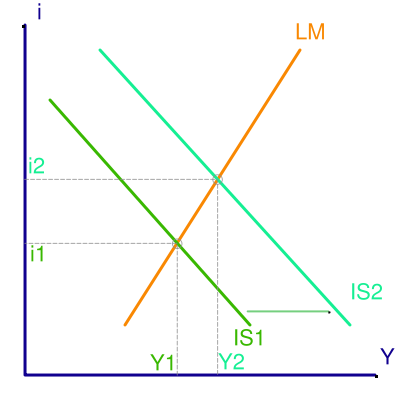We have seen that changes in government purchases, taxes and transfer payments can have an impact on equilibrium aggregate demand. When a government deliberately changes its spending or taxation policies in order to influence aggregate demand, we call that "fiscal policy." But there is another, more automatic way that spending and taxation can influence the economy.
- Some kinds of taxes rise more than proportionately when income increases. A progressive income tax is an example of this. "progressive" means that the tax rate is higher on higher incomes. Thus, when income in general increases, more people are in the higher tax brackets, and so the average tax rate is higher.
- Some kinds of transfer payments and government purchases rise when income drops. Unemployment compensation and income supplements for poor people are examples, as are purchases of services for the poor. When income in general drops, there are more poor people eligible for these transfers and services, so spending on them increases.
These taxes, transfers, and purchases are automatic stabilizers of the economy. To see why, think of what happens when the economy goes into a recession, perhaps because of a sudden drop in autonomous consumption. The progressive taxes drop even faster than income, and this decrease in taxes has a multiplier effect, partly offsetting the drop in autonomous consumption, so that equilibrium income doesn't drop as far or as fast as it could. Similarly, the transfers to and services for the poor increase, and these too have multiplier effects and tend to offset the drop in autonomous consumption. Thus, equilibrium aggregate demand drops less than it would have dropped simply because of the decrease in autonomous consumption alone. The economy is more stable.
This works the other way in a boom. An example is the year 1997 in the U. S. A. At the beginning of the year, our government was divided over plans to gradually reduce the government deficit to zero by sometime in the next century. By the end of the year, the deficit was much lower than anyone had anticipated. This happened because, over the year, steady growth of production reduced unemployment to its lowest rate in twenty-five years. This increased growth raised tax revenues and cut transfers, reducing the government deficit. Incidentally, the multiplier theory tells us that the dropping deficit will also have slowed the growth of production, partly offsetting the rise in aggregate demand that would otherwise have occurred.
On the whole, these automatic stabilizers are probably a good thing. If the government has to pass a law to cut taxes in a recession, for example, that can be a time-consuming process. First, the government has to be made aware that there is a recession, and then it makes a law, and then the law takes some time to go into effect. By the time it has an effect, the recession may very well be over and a boom going on -- so that instead of stabilizing the economy, the tax cut makes it less stable. Automatic stabilizers can act in a much quicker and more timely fashion.
We may also hope that the government deficits in recession periods will be offset by government surpluses in boom periods. This is called a "cyclically balanced budget," and probably is the only realistic kind of balanced budget. Unfortunately, it is a potentiality -- a hope -- not a fact.
*Transfer Payment = Payment of money by government to individual for which the payer receive no good @ service directly in return..







